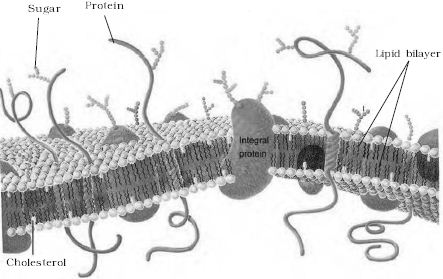The detailed structure of the membrane was studied only after the advent of the electron microscope in the 1950s. Meanwhile, chemical studies on the cell membrane, especially in human red blood cells (RBCs), enabled the scientists to deduce the possible structure of plasma membrane.
The cell membrane is composed of lipids that are arranged in a bilayer. Also, the lipids are arranged within the membrane with the polar head towards the outer sides and the hydrophobic tails towards the inner part. This ensures that the nonpolar tail of saturated hydrocarbons is protected from the aqueous environment (Figure).

The lipid component of the membrane mainly consists of phosphoglycerides. Later, biochemical investigation dearly revealed that the cell membranes also possess protein and carbohydrate. The ratio of protein and lipid varies considerably in different cell types. In human beings, the membrane of the erythrocyte has approximately 52 percent protein and 40 percent lipids.
Depending on the ease of extraction, membrane proteins can be classified as integral or peripheral. Peripheral proteins lie on the surface of membrane while the integral proteins are partially or totally buried in the membrane.
One of the most important functions of the plasma membrane is the transport of the molecules across it. The membrane is selectively permeable to some molecules present on either side of it. Many molecules can move briefly across the membrane without any requirement of energy and this is called the passive transport. Neutral solutes may move across the membrane by the process of simple diffusion along the concentration gradient. i.e. from higher concentration to the lower. Water may also move across this membrane from higher to lower concentration. Movement of water by diffusion is called osmosis.











